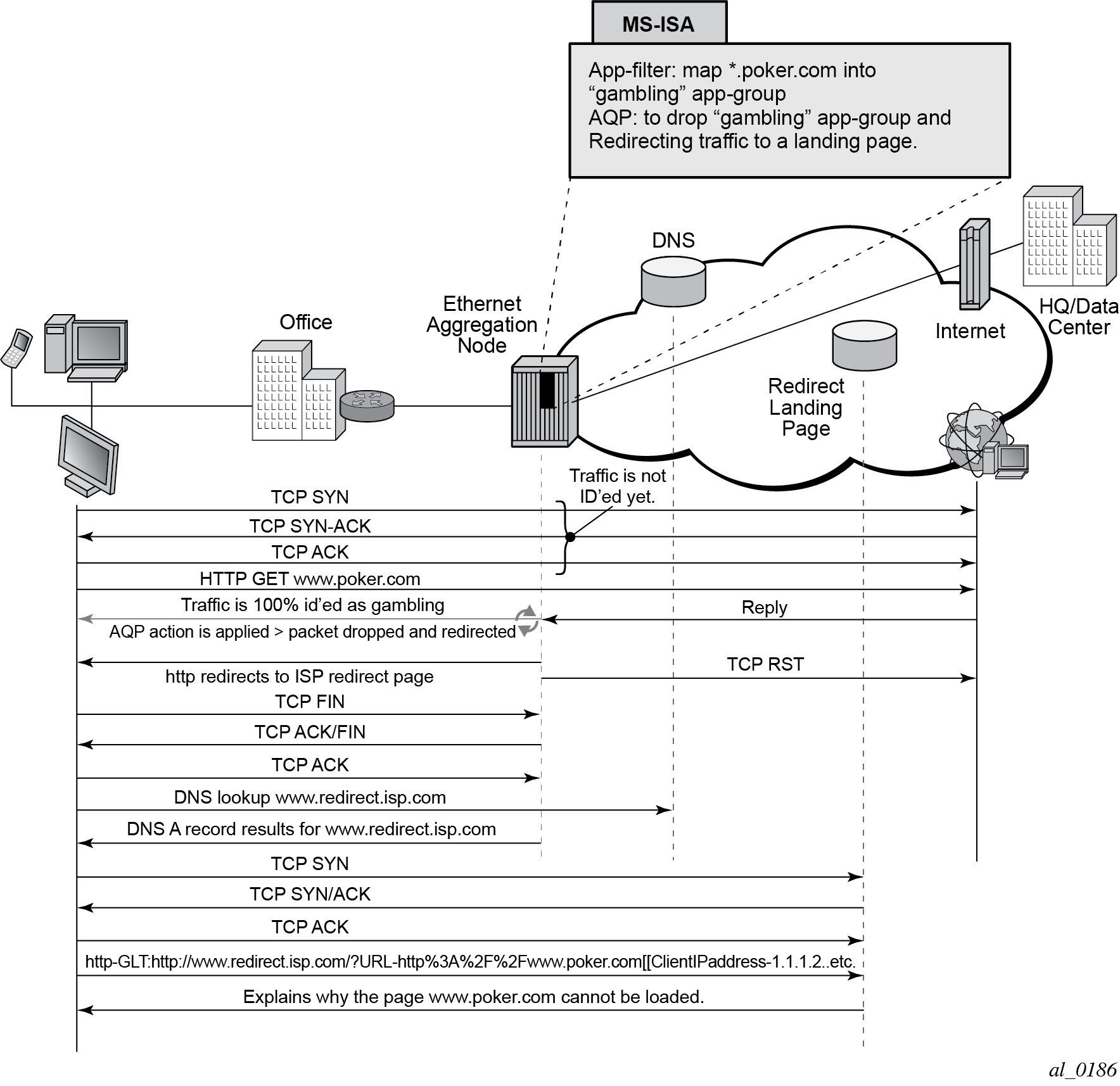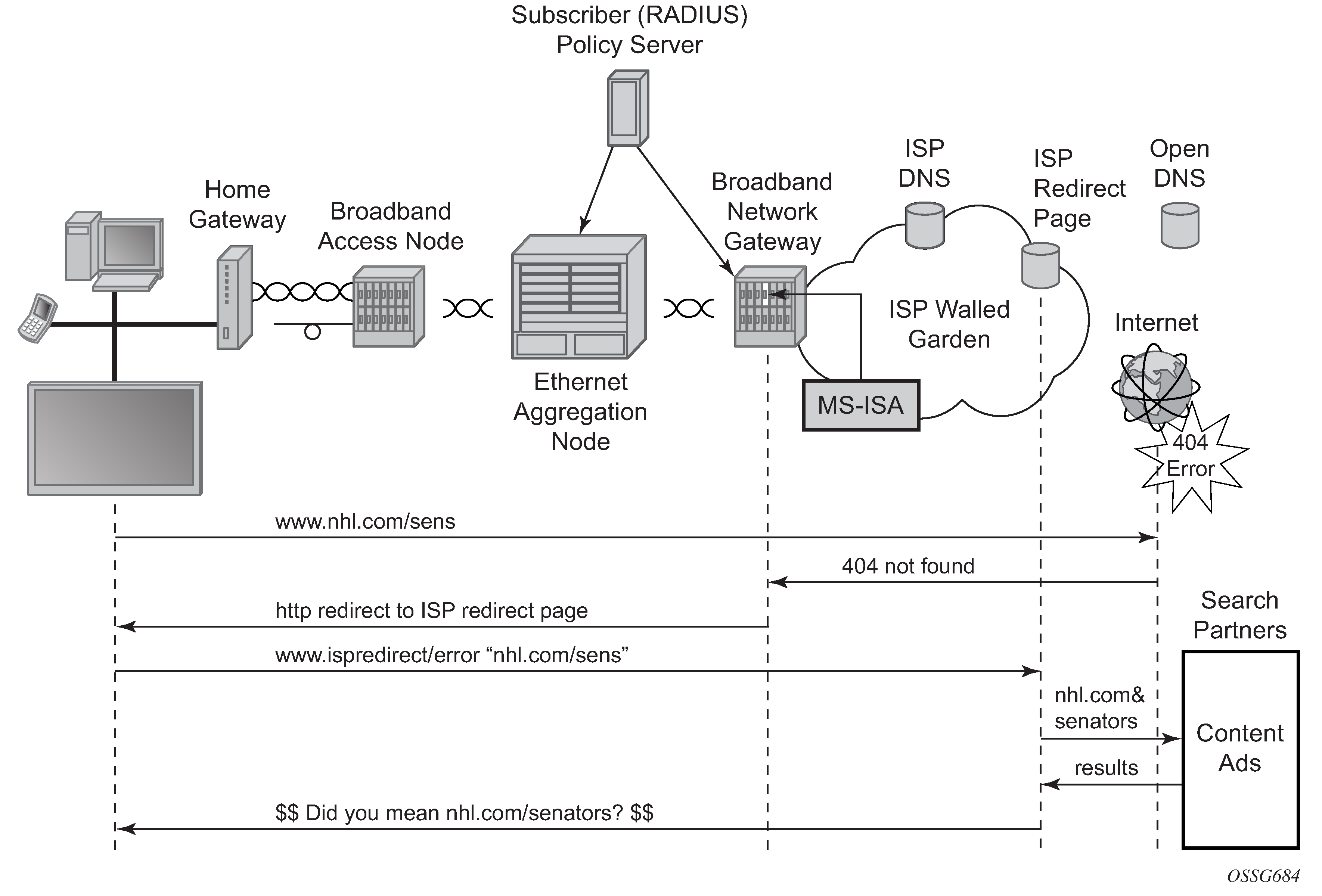-
AA HTTP policy redirect
With AA ISA HTTP policy based redirect feature, when HTTP flows are blocked, the user is directed to a web portal that displays relevant messages to indicate why the HTTP traffic is blocked, such as: time of day policy to block youtube.com, top-up request, and so on.
Without HTTP policy redirect, when HTTP flows are blocked, the subscriber application retries and before it times-out.
AA ISA provides full customer control to configure an AQP action that redirects traffic that matches the AQP match criteria. Hence, the HTTP redirect service can be applied at any level (application, application group, specific subscribers, specific source IP addresses) or any other AQP match criteria.
To illustrate, say the operator configures www.poker.com as a ‟gambling” app-group.
The operator configures AA_ISA to drop and redirect all HTTP traffic classified under ‟gambling” app-group to www.redirect.isp.com. When a client/subscriber initiates an HTTP GET for www.poker.com. Traffic to poker.com is dropped at the AA ISA. AA ISA issues a redirect to the client. [in the redirect, information about the user are encoded in the PATH message, such as www.poker.com, sub-ID, sub-type, reason for redirect (=AQP drop action) AA application name]. Client, unaware of the drop, responds to the redirect.
Redirect landing page describes to the user why the page at www.poker.com is not accessible. See Figure: HTTP redirect because of URL block.
Figure: HTTP redirect because of URL block
AA ISA allows the operator to configure HTTP redirect policies. An HTTP redirect policy contains, most importantly, the HTTP host to be used for the redirect. Within the AQP actions, such polices can be linked (like policers). Redirect takes place only if the AQP configured matching criteria is met and the HTTP flow is dropped (because of other AQP actions, such as ‟drop”, flow-count/rate policers). The redirect only applies to HTTP traffic. Non-HTTP flows (even if the conditions above are met) are not redirected (no redirect for RTSP traffic).
The HTTP redirect policy includes an option for TCP-client-reset. This is used to improve the end-user experience when TCP traffic that cannot be HTTP redirected is blocked. Resetting the client TCP session avoids the client waiting for tcp session timeout. The ISA initiates a TCP reset toward the client if the AA policy results in an http-redirect with packet drop but the HTTP redirect cannot be delivered. Scenarios for this include blocked HTTPs (TLS) sessions, blocking of non-HTTP traffic, and blocking of existing flows after a policy re-evaluate of an existing subscriber. A mid-session policy change to redirect and block traffic for a sub causes a TCP reset of existing non-http tcp sessions when the next packet for those sessions arrives. For example, when the packet is dropped.
-
AA HTTP 404 redirect
HTTP status code-based redirect feature provides error resolution and search technology that enhances the Internet experience for end customers while generating new revenue stream for the ISP.
Nokia’s AA ISA HTTP status code-based redirect feature, along with its partners Barefruit or Xercole, replaces unhelpful DNS and HTTP error messages with relevant alternatives, giving the user a search solution instead of no direction. Customers benefit from an improved surfing experience as they are served relevant results that can help them find what they were looking for. The ISP, on the other hand, receives a share of the search revenue.
Every time an end-user clicks on a broken link (Page Not Found), an error page displays. Frequently, a search provider produces results, through a browser plug-in, for that user. This generates revenue for the search provider if the user clicks on a paid link.
With AA ISA HTTP status code-based redirect feature, the user sees high-quality, relevant search results. In addition, instead of the search provider receiving all of the revenue, the ISP is paid every time a user clicks on a sponsored link.
AA ISA provides full customer control to configure an AQP action that redirects traffic that matches the AQP match criteria (Figure: AQP actions). Hence, the HTTP redirect service can be applied at any level (application, application group, specific subscribers, specific source IP addresses) or any other AQP match criteria.
Figure: AQP actions
HTTP headers are intercepted by AA ISA on the return path from the requested web site. If the HTTP status code is a non-custom 404, then the response is replaced with JavaScript that redirects the client to the Contextual Analysis Servers (Barefruit server). This redirect contains details of the original URI that gave rise to the 404 error.
The operator can configure AA ISA HTTP 404 redirect to use either Barefruit or Xerocole partner contextual analysis servers. A redirect policy can be defined at the AA group level (similar to policers), and then referenced as many times as needed in AQP actions. The system allows a maximum of one HTTP 404 redirect policy per AA group.